#wave-particle duality
Text


A collection of wearable 3D art inspired by science:
✦ NEW: Wave-Particle Duality Pendant
✦ The Wave-Particle Duality Rings
✦ A Candle in the Dark: Lantern Earrings
Available now on Shapeways!
✦ Shapeways.com/shops/nature-in-theory
✦ Linktr.ee/NatureInTheory
Original designs © Olena Shmahalo / Nature in Theory
#3D printed jewelry#3D jewelry#3D art#3D printed#natureintheory#olena shmahalo#portfolio#2023#wave-particle duality#double slit experiment#particle physics#quantum physics#steampunk#gaslamp fantasy#darkacademia#shapeways#shapeways jewelry#goth jewelry#nerd jewelry#science jewelry#physics jewelry#science illustrator#sff art#scifi art#fantasy art#3D#noai#human artist
188 notes
·
View notes
Text
"Multiplicity is only apparent, in truth, there is only one mind."

Erwin Schrödinger was an Austrian physicist
Born 12 August 1887
Died 4 January 1961
#Erwin Schrödinger#Austrian physicist#Quantum mechanics#Schrödinger equation#Wave function#Quantum theory#Cat paradox#Nobel Prize in Physics#Quantum superposition#Wave-particle duality#Schrödinger's cat#Quantum entanglement#Quantum probability#Quantum states#Quantum mechanics interpretation#Particle physics#Quantum wavefunction#Copenhagen interpretation#Quantum philosophy#Quantum mechanics history#Quantum theory applications#Quantum theory development#Quantum theory principles#Schrödinger group#Quantum mechanics equations#Quantum mechanics principles#Quantum mechanics concepts#Quantum mechanics wave equation#Quantum mechanics wavefunction#Quantum mechanics discoveries
7 notes
·
View notes
Text
Wave-Particle Duality and the Dragon
A PHYSICS PRIMER AND A THOUGHT EXPERIMENT by John Alipio
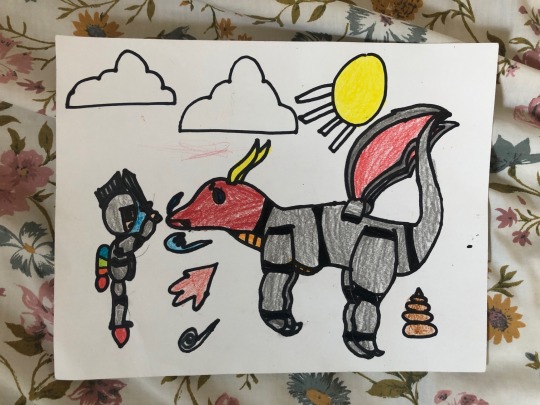
-Artwork by Oliver A.
The Double Slit Experiment
A fundamental mystery of quantum mechanics is wave-particle duality.
Waves and particles have very different properties. Multiple waves can exist in the same place at the same time, and they interfere with each other, meaning they cancel and amplify each other (e.g., sound and water waves). Particles, on the other hand, cannot be in the same place at the same time, and the energy of multiple particles is the sum of their individual energies (e.g., a baseball).
A wave-particle behaves as a wave in some circumstances and as a particle in other circumstances. It has both a wave nature and a particle nature. Light and the electron, which we will talk about further, are examples of wave-particles.
Thomas Young’s famous double split experiment is one way to demonstrate the wave-particle nature of light. To summarize, in this experiment, light is projected at a barrier which has two narrow slits. A screen is set up beyond the barrier to absorb the light after it passes through the slits. With a laser and some precise materials, this experiment can be easily replicated in a classroom.

The light passes through both slits, and the resulting waves overlap with each other and interfere. That is, they amplify or cancel each other to create an interference pattern. Because they are identical waves in wavelength and frequency, they create a pattern like this on the screen.

This interference pattern is proof that light behaves as a wave.
However, when the light hits the screen, it behaves as a particle. The light gets absorbed by the screen as individual packets of energy we call photons. The energy of the photons add up as we would expect energy of particles.
Although much trickier to pull off, the double slit experiment for electrons works similarly. Individual electrons are fired through the double slits. At first, the pattern that the electrons create on the screen seems random, but as more electrons are fired, a clear interference pattern emerges, which would be indication that the electron is interfering with itself as if it moved through both slits as a wave.
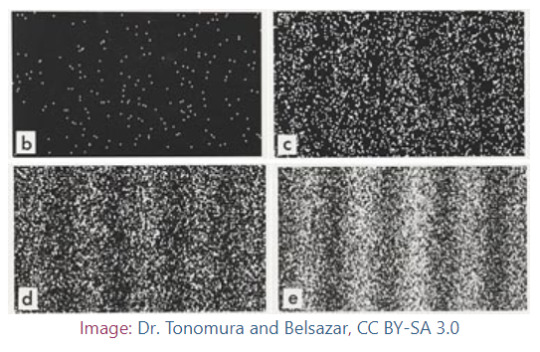
At the quantum level, the only way physics is able to describe and predict behavior is with mathematical probabilities. This means, when thinking about the electron, we have to allow for different possibilities to exist at the same time.
From a mathematical standpoint, there is a 50/50 probability that the electron will go through one slit or the other. The uncertain electron does not have to go through one slit or the other, so it is presumed to go through both slits (behaving like a wave).
Now introduce a detector which can record which slit the electron goes through. As soon as it records that information, the electron no longer has the “choice” of going through either slit or both slits. It must obey the laws of probability. The electron can only go through one slit. The pattern seems random again at the start, but as more electrons are fired, the pattern it creates is different. Instead of the wavy interference pattern we saw before, we see a pattern of two stripes, as if there was no interference with itself (behaving like a particle). This works the same with photons of light.

Marcus de Brun (https://physics.stackexchange.com/users/179575/marcus-de-brun), Double Slit Experiment. What effect does the detector actually cause? (https://physics.stackexchange.com/q/376494)
Light (and all other electromagnetic radiation) and electrons (and all other quantum objects) have wave-particle duality. Sometimes they behave as waves, sometimes they behave as particles. It depends on the circumstances in which they are detected.
The Dragon
You stand before a closed door, behind which there is a dragon. As the old maps depict, the dragon represents the unknown, the edges of our understanding.
No one knows for sure if the dragon exists or its shape, but the news of the dragon spreads through word of mouth, written word, movie, song. The thought of the dragon takes on a different shape for each person. Each has their own response— fear, curiosity, indifference, boldness. Their responses are individual, but as they interact with one another, their responses are magnified or diminished.
The dragon, for the time being, remains unconfirmed, but its impact is real. Like a wave, it rumbles through the community.
Suddenly everything changes, for you open the door and walk through. All the possibilities converge into one truth. The dragon will eat you, or it won’t.
The truth transforms you in a much more permanent way than the dragon behind the door. The truth leaves a mark.
Thanks for reading. Love,
John

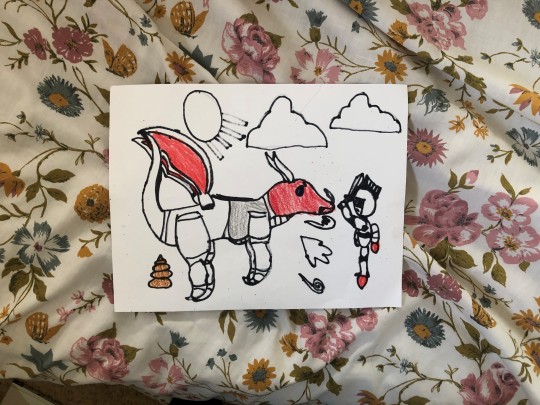
0 notes
Text
Chapter 17: Introduction to Quantum Mechanics
17.1 Quantum Mechanics Overview
Quantum mechanics is the branch of physics that deals with the behavior of particles at the atomic and subatomic levels. It emerged in the early 20th century as a response to the limitations of classical mechanics and electromagnetism, which failed to describe the observed behavior of particles at the microscopic scale. This chapter introduces the basic principles…
View On WordPress
0 notes
Text
Wave-particle duality (idea 1/2 behind quantum mechanics)
this video tells me that i really don't understand any of this all (idk i don't get the wave function, any of the math, or anything to do with superpositions...like, why are they superimposed??) but i'm going to try to make sense of what the book says about de Broglie wavelengths anyway...because i kind of just have to for this intro chem course...
If EMR (energy) sometimes behaves like a particle and sometimes behaves like a wave, small particles of matter may also behave sometimes like a particle and sometimes like a wave. These waves are called phase waves aka matter waves and their wavelength is called a de Broglie wavelength. Mathematically, he expressed this by taking Einstein's equation for momentum of a photon and the formula for momentum of matter p = mu and putting them together like this:
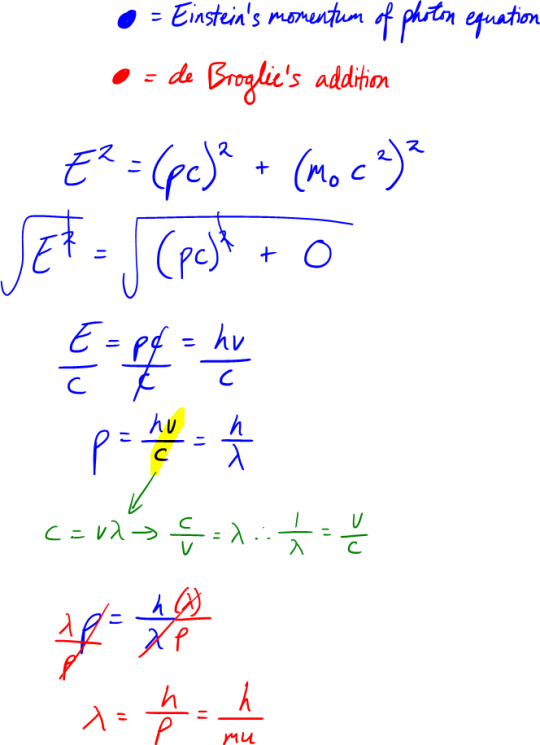
where m = mass of particle in kg, u = velocity in m/s, lambda = de Broglie wavelength in m, h = Planck's constant (J*s → [kg*m^2/s^-2]*s)
If phase waves aka matter waves exist for small particles, electrons should exhibit wave-like properties like diffraction. E.g. shoot x-ray photons of wavelength 100 pm at aluminium atoms spaced 200 pm apart and you get an x-ray diffraction pattern. Repeat the experiment with electrons of wavelength 100 pm and you see the same diffraction pattern.


Wave-particle duality applies to all objects, big and small, but it's only important when the wavelengths are significant relative to the dimensions of the objects you're talking about (i.e. de Broglie wavelengths are only significant relative to dimensions of atoms or nuclei, so wave-particle duality is important for those small objects). Macroscopic objects have wavelengths too small to measure, so you don't need to account for wave-particle duality for them (laws of classical physics suffice). (Mathematically, we can see that the more we increase mass, the smaller the wavelength will be. At a macroscopic level, that wavelength is negligible.)
E.g. wave-particle duality is important when you're dealing with de Broglie wavelengths of 24.2 pm and a distance between 2 atoms of 200 pm. Wave-particle duality is NOT important when you're dealing with de Broglie wavelengths of 24.2 pm and a much larger dimension (e.g. those of macroscopic objects). It's like saying a human lifetime is significant relative to a millisecond but it's insignificant relative to the age of the universe.
E.g. of using de Broglie's formula:

#stem academia#stemblr#chemblr#stem student#quantum mechanics#wave-particle duality#quantum physics#physics#chemistry#my unsolicited notes
1 note
·
View note
Text
#mine is the electron for obvious reasons#gotta love that wave particle duality#chemistry#polls#science#biochemistry
30 notes
·
View notes
Text

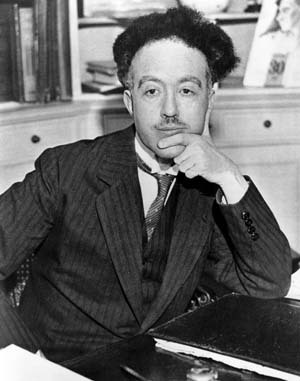
Genshin reference to Louis de Broglie, french physicist who did amazing work in quantum mechanics, theorectically demonstrating the wave-particle duality of matter. As in "de Broglie wavelength". Love to see it!
#genshin#genshin impact#fontaine#genshin fontaine#broglie#de broglie#quantum mechanics#quantum physics#wave particle duality#physics
26 notes
·
View notes
Text
normal people please tell me how old were you when you learned about things being both particles and waves
#wizardspeak#people who were also surrounded by physicists from an early age also tell me i need to know...#like im aware most ten yr olds did not have quantum physics books but wave particle duality is like common knowledge right
8 notes
·
View notes
Text
I did the DOUBLE SLIT EXPERIMENT at home!
Light travels as a wave here (and not as a particle).
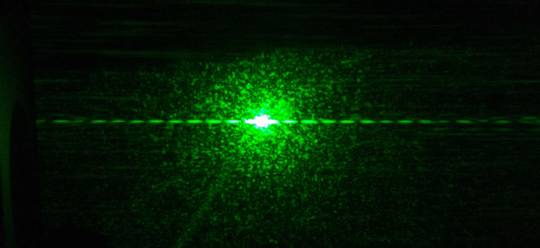
1 note
·
View note
Text
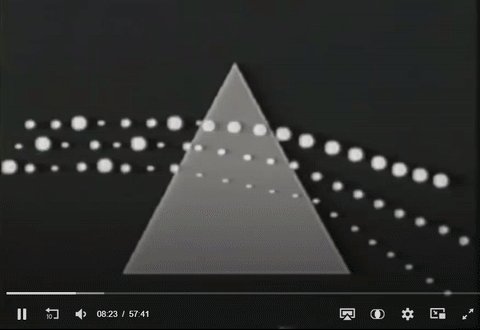
Newton's corpuscular theory of light. Senior physics: Wave - particle duality. (1984)
#isaac newton#photon#wave particle duality#physics#science education#rainbow#colour spectrum#animation#analog video#1984#1980s
4 notes
·
View notes
Text



New particle physics jewelry:
The Wave-Particle Duality Pendant
More pictures of the whole collection in this post, and here:
✦ OlenaShmahalo.com/project/objects
✦ Shapeways.com/shops/nature-in-theory
#3D printed jewelry#3D jewelry#3D art#3D printed#natureintheory#olena shmahalo#portfolio#2023#wave-particle duality#double slit experiment#particle physics#quantum physics#steampunk#gaslamp fantasy#darkacademia#shapeways#shapeways jewelry#goth jewelry#nerd jewelry#science jewelry#physics jewelry#science illustrator#sff art#scifi art#fantasy art#3D#noai#human artist
41 notes
·
View notes
Text
Yes, yes, Oppenheimer is a delightful little jaunt into the question of moral responsibility and the devastating effects of science and all that but like. Is anyone going to talk about how Oppy looked like a butch lesbian that whole movie??
#oppenheimer#he had some queer vibes#either he's a trans man#or he's a trans lesbian#no one cis goes that far into quantum physics#understanding particle wave duality while not having similar thoughts on gender??#impossible
5 notes
·
View notes
Text
Planck's Constant
Introduction
Planck’s constant, denoted by $h$, is a fundamental constant of nature that plays a central role in the theory of quantum mechanics. It is named after the German physicist Max Planck, who first proposed its existence. Planck’s constant is a measure of the granularity of the physical world at the microscopic level, and it sets the scale for the smallest possible action in the…
View On WordPress
0 notes
Text

#life the universe and everything#42=101010#wave particle duality#trinity#nature#science#art#philosophy#religion
5 notes
·
View notes
Text

#particle-wave duality#particle#wave#physics#particle physics#quantum mechanics#wavefunctions#wavelengths#credit:maschen#diagram#svg#transparent
14 notes
·
View notes
Text
hm ok i think when i finish finals i will post the second half of the sun summoner kaz/shadow summoner inej au
#i have had it 70% written since january then i went back to school#heists are difficult#mainly i like that i got to discuss wave particle duality
7 notes
·
View notes